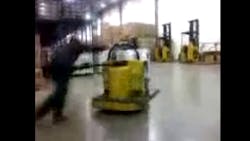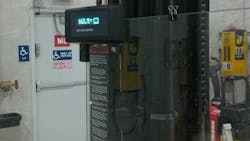As safety manager for Lawson Products, an industrial product and service provider, Nick Del Vecchio has seen his share of mistakes people make while operating forklifts. So after viewing our video gallery of Dumb Things People do with Forklifts, he called me and told us we’re missing a common one: pallet truck spins. He’s right. I checked and they’re all over Youtube.
You’ll see not only spins, but drifts and races too. To employees with extra time on their hands and a deficit of brain cells in their heads, lift trucks start looking like skateboards and go-carts. What you’ll see online are the videos these idiots want you to see. You won’t see many of the not-so-funny instances where somebody gets seriously hurt on the job. For that angle you need someone like Del Vecchio around to nip this horseplay in the bud. He’ll tell you how failure to respect the power of these vehicles can be a costly mistake.
During our phone conversation, Del Vecchio told me that even serious operators can get into trouble by not realizing how challenging operating lift trucks can be—especially when handling loads at height. Naturally, these operators want to be productive, but this safety professional takes his title seriously and is therefore willing to sacrifice a little extra speed for extra safety.
“You’ll see videos where, as operators start approaching the area they want to reach, they’ll start lifting the forks and turning the truck at the same time,” he told me. “We discourage that. We’re old school and want them to turn into a location with the folks down, then line themselves up before lifting the forks to the location they want to reach. Once they reach that level, we want them to reach out, pick up the load, bring it back to the mast and lower it all the way before beginning their turn. A lot of veteran drivers think, ‘I’ve driven reach trucks before, this is a no brainer.’ Well I drove forklifts before too, but the highest we went to was 16 ft. Here, dealing with racks almost twice that high, it can get very hairy.”
Oh, and those videos of the pallet jack stunts Del Vecchio told me about? He mentions them to his employees too, in instructing them about lift truck safety.
“In one of these videos (which we've added to our gallery which you can connect to below) the operator went so fast he was thrown off,” Del Vecchio said. “We have such jacks and we tell our people they’re probably the most dangerous vehicles we have. Many times they don’t believe me, but I tell them that these are like little jackrabbits and if you drive them too fast and make a turn too sharp you’ll get thrown from it. This one guy didn’t believe me and while we were testing, he went off really fast, made a real sharp turn and it threw him off. He didn’t get hurt but he was embarrassed. Two days later I found out all the parameters on these trucks were set at top speed so even when pulling away with a load or coming up, it was set at jackrabbit. I set them all down to the lowest level and the same guy said, ‘Nick there’s something wrong with these things. They start off real slow.’ I said, ‘Well then it’s working because I set them that way.’”
“That seems to have helped a great deal because people were really afraid to go into those upper racks for anything,” Del Vecchio concluded.
It’s good to hear there’s still some fear left in warehouse workers. It’s a sign of intelligence.
About the Author
Tom Andel Blog
former Editor-in-Chief
As editor-in-chief from 2010-2014, Tom Andel oversaw the strategic development of MH&L and MHLnews.com, bringing 30+ years of thought leadership and award winning coverage of supply chain, manufacturing logistics and material handling. Throughout his career he also served in various editorial capacities at other industry titles, including Transportation & Distribution, Material Handling Engineering, Material Handling Management (predecessors to MH&L), as well as Logistics Management and Modern Materials Handling. Andel is a three-time finalist in the Jesse H. Neal Business Journalism Awards, the most respected editorial award in B2B trade publishing, and a graduate of Cleveland’s Case Western Reserve University.



